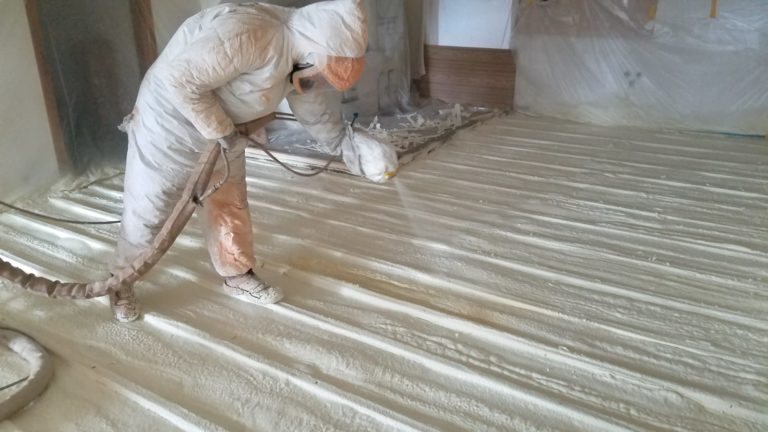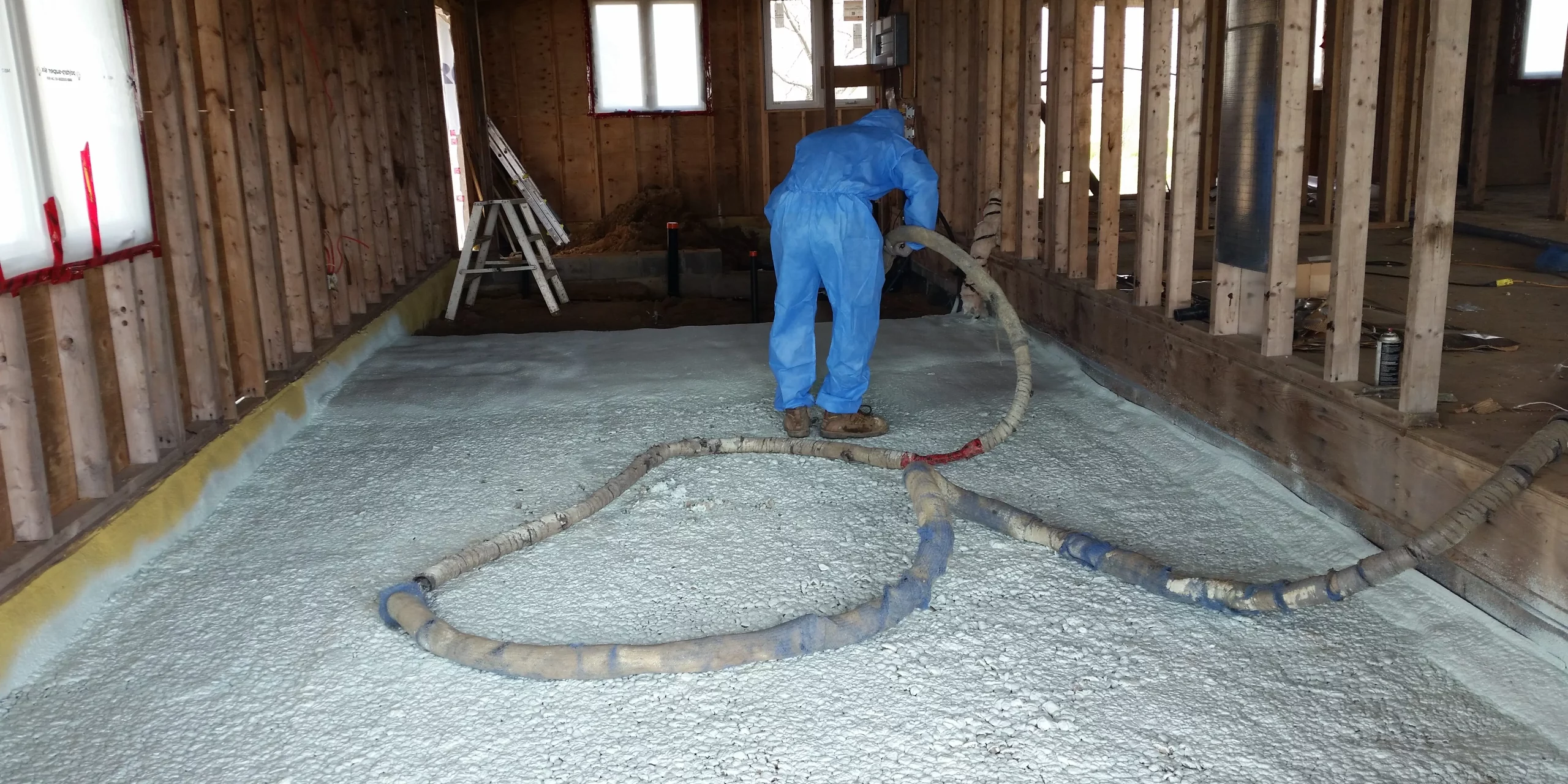Floor insulation represents a significant missed opportunity in code-minimum builds due to minimal requirements that fail to address thermal bridging, air sealing deficiencies, and energy loss pathways that can account for 10-25% of total building heat loss. Code minimum floor insulation requirements range from R-13 to R-30 depending on climate zone, but these standards neglect critical areas including rim joists, cantilevers, and thermal bridges that create substantial performance gaps. Modern floor insulation strategies can achieve 15-30% additional energy savings while improving comfort and preventing moisture issues.
The opportunity stems from outdated code assumptions that prioritize simple cavity fill over comprehensive thermal boundary management. Advanced floor insulation approaches address air leakage, thermal bridging, and moisture control simultaneously, delivering whole-building performance improvements that far exceed the incremental material investment required.
Code Minimum Floor Requirements vs Performance Reality
Current IECC Floor Insulation Standards
The 2021 IECC establishes minimum floor insulation requirements that vary significantly by climate zone, with most falling short of optimal performance levels needed for comprehensive energy efficiency.
Climate Zone
Floor R-Value Requirement
Typical Cavity Depth
Performance Gap
Zone 1
R-13
2x10 joists
Minimal thermal boundary
Zone 2-3
R-13-19
2x10-2x12 joists
Inadequate air sealing
Zone 4-5
R-19-30
2x12+ joists
Thermal bridging ignored
Zone 6-8
R-30-38
2x12+ joists
Rim joist neglected
These requirements focus exclusively on cavity insulation while ignoring critical thermal performance factors. Floor insulation requirements have remained largely static since 2009 in most climate zones, failing to evolve with advancing building science understanding.
Thermal Bridging Impact on Floor Performance
In a typical stick-frame house, lumber occupies 27% of the wall area, and similar thermal bridging occurs in floor systems where joists create continuous conductive pathways. Floor joists with R-1.25 per inch thermal conductivity significantly reduce overall assembly performance compared to rated cavity insulation values.
Bonus Tip: According to John Straube, around 25% thermal performance reduction occurs due to thermal bridging in wood-framed assemblies, making continuous insulation strategies essential for optimal performance.
[Image: Cross-section diagram showing thermal bridging through floor joists with heat loss pathways highlighted in red]
Critical Floor Areas Overlooked by Code Minimum
Rim Joist and Band Board Insulation
Rim joists need insulation as they can be a significant source of heat loss and air leakage, affecting energy efficiency and indoor comfort. These critical transition zones between foundation and floor systems often receive minimal attention in code-minimum builds despite representing major thermal weak points.
Rim Joist Treatment
Air Leakage Rate
Thermal Performance
Installation Complexity
Uninsulated
15-25 CFM50/linear foot
R-1.5 effective
No installation
Fiberglass batts
8-15 CFM50/linear foot
R-8-12 effective
Low complexity
Rigid foam boards
3-8 CFM50/linear foot
R-15-20 effective
Moderate complexity
Spray foam sealed
0.5-3 CFM50/linear foot
R-20-25 effective
Professional required
Cantilever and Overhang Deficiencies
If these floor joist bays remain open, cold air can flow in the joist space between the floors, creating substantial energy losses in cantilever areas. Often, the insulation installed in these cantilevers has fallen away from the flooring above, creating a leaky air gap and rendering the insulation useless.
Code-minimum approaches typically specify cavity insulation without addressing air barrier continuity or comprehensive sealing strategies needed for effective cantilever performance.
Floor-to-Wall Transition Zones
Critical junction areas where floors meet exterior walls frequently lack adequate insulation and air sealing specification in code-minimum approaches. These thermal bridges can account for significant energy loss while creating moisture condensation risks.
[Image: Thermal imaging comparison showing heat loss patterns in code-minimum vs high-performance floor assemblies]
Air Sealing Deficiencies in Standard Floor Assemblies
Penetration Management
Standard floor construction creates numerous air leakage pathways through utility penetrations, floor-to-wall intersections, and subfloor joints that code-minimum approaches fail to address comprehensively.
Penetration Type
Typical Air Leakage
Sealing Strategy
Performance Impact
Electrical boxes
5-15 CFM50 each
Foam gaskets/caulk
Moderate
Plumbing pipes
8-25 CFM50 each
Boot seals/foam
High
HVAC penetrations
15-50 CFM50 each
Collar seals/mastic
Very High
Subfloor seams
2-8 CFM50/linear foot
Adhesive/tape
Cumulative
Subfloor Air Barrier Continuity
Code versions before the 2015 International Energy Conservation Code (IECC) and 2015 International Residential Code (IRC) required floor insulation to be in direct contact with the underside of subfloor decking. Current approaches allow air gaps without addressing comprehensive air barrier strategies.
Bonus Tip: Proper subfloor air barrier implementation can reduce floor assembly air leakage by 60-80% compared to standard construction practices.
Moisture and Comfort Implications
Vapor Management in Floor Assemblies
Enhanced floor insulation strategies require careful moisture management to prevent condensation issues while maintaining indoor air quality and structural integrity.
Assembly Type
Vapor Control Strategy
Moisture Risk
Performance Durability
Vented crawlspace
Vapor barriers at floor
Moderate
Good
Unvented crawlspace
Wall insulation/sealing
Low
Excellent
Basement applications
Interior insulation
Low-Moderate
Very Good
Slab-on-grade
Perimeter continuous
Very Low
Excellent
Comfort and Indoor Air Quality
Comprehensive floor insulation delivers significant comfort improvements through reduced drafts, more uniform temperatures, and enhanced moisture control compared to code-minimum approaches.
[Image: Comfort zone comparison showing temperature stratification differences between code-minimum and enhanced floor insulation]
Economic Performance Analysis
Energy Savings Potential
Enhanced floor insulation strategies typically achieve 15-30% reductions in heating and cooling loads compared to code-minimum approaches, with payback periods of 5-12 years depending on climate zone and energy costs.
Climate Zone
Annual Energy Savings
Simple Payback
Lifecycle Value
Zone 1-2
8-15%
8-15 years
Moderate
Zone 3-4
12-22%
6-12 years
Good
Zone 5-6
18-28%
5-10 years
Very Good
Zone 7-8
20-35%
4-8 years
Excellent
Installation Cost Considerations
While enhanced floor insulation requires higher initial investment, the incremental costs are typically modest when integrated into new construction workflows compared to retrofit applications.
Bonus Tip: Coordinating floor insulation with other building envelope improvements can reduce installation costs by 20-40% through shared labor and material efficiencies.
Things to Consider Before Making a Decision
Climate Zone Requirements: Higher climate zones offer greater economic benefits for enhanced floor insulation due to extended heating seasons and higher energy loads. Southern climates may prioritize moisture management over maximum R-values.
Foundation Type Compatibility: Different foundation systems require tailored floor insulation strategies. Basement applications differ significantly from crawlspace or slab-on-grade requirements in terms of optimal insulation placement and moisture management.
Building Use Patterns: Residential occupancy patterns, heating/cooling preferences, and comfort expectations influence optimal floor insulation strategies. Commercial buildings may have different performance priorities.
Future Renovation Plans: Consider long-term accessibility for maintenance and potential system upgrades. Some floor insulation strategies are easier to modify or improve over time than others.
Local Code Variations: Many jurisdictions modify IECC requirements or have additional standards that may affect optimal floor insulation approaches. Verify local requirements before design.
HVAC System Integration: Floor insulation strategies should coordinate with heating and cooling system design, ductwork placement, and overall building performance objectives.
Moisture Risk Assessment: Local climate conditions, soil characteristics, and building orientation affect moisture management requirements for floor assemblies.
Common Questions About Enhanced Floor Insulation
Installation Timing Coordination: Enhanced floor insulation requires coordination between multiple trades including framing, mechanical, and insulation contractors. Planning installation sequences prevents conflicts and ensures optimal results.
Code Compliance Verification: Enhanced approaches must demonstrate compliance with building codes while potentially exceeding minimum requirements. Documentation and inspection coordination become more important.
Performance Verification Methods: Thermal imaging, blower door testing, and energy monitoring can verify enhanced floor insulation performance. These tools help identify installation defects and optimize performance.
Maintenance and Durability: Enhanced floor insulation systems require consideration of long-term performance, accessibility for maintenance, and material durability under various environmental conditions.
Floor Insulation FAQ
Q: How much additional energy savings can enhanced floor insulation provide compared to code minimum? A: Enhanced floor insulation typically achieves 15-30% additional energy savings compared to code-minimum approaches, with the greatest benefits in Climate Zones 4-8 where heating loads are substantial.
Q: What are the most critical areas often missed in standard floor insulation? A: Rim joists, cantilevers, floor-to-wall transitions, and utility penetrations represent the most significant missed opportunities in code-minimum floor insulation approaches.
Q: Does enhanced floor insulation create moisture problems? A: Properly designed enhanced floor insulation includes comprehensive moisture management strategies that typically reduce rather than increase moisture risks compared to code-minimum approaches.
Q: Can floor insulation improvements be cost-effectively retrofitted? A: Retrofit applications are more expensive but can still provide positive returns, especially when combined with other building envelope improvements or during major renovations.
Q: How does enhanced floor insulation affect HVAC sizing and performance? A: Comprehensive floor insulation reduces heating and cooling loads, potentially allowing smaller HVAC equipment while improving comfort and system efficiency.
Make the Right Decision
Floor insulation represents one of the most significant missed opportunities in code-minimum builds, offering substantial energy savings, comfort improvements, and moisture management benefits. The gap between minimum code requirements and optimal performance is particularly pronounced in floor assemblies where thermal bridging, air leakage, and moisture issues converge. Enhanced floor insulation strategies address these comprehensive performance factors while remaining cost-effective for most applications.
Evaluate your specific climate zone, foundation type, and performance objectives when considering enhanced floor insulation approaches. Coordinate with qualified professionals who understand building science principles and can integrate floor insulation with overall building envelope performance. Document performance expectations and verify installation quality through appropriate testing and inspection procedures.
Contact Raleigh Excel Spray Foam Insulation at (919) 301-9435 or [email protected]

Reviewer: With nearly a decade in the spray foam insulation field, William Harris reviewed this post and provided guidance that reflects both technical understanding and real-world marketing experience





Comments